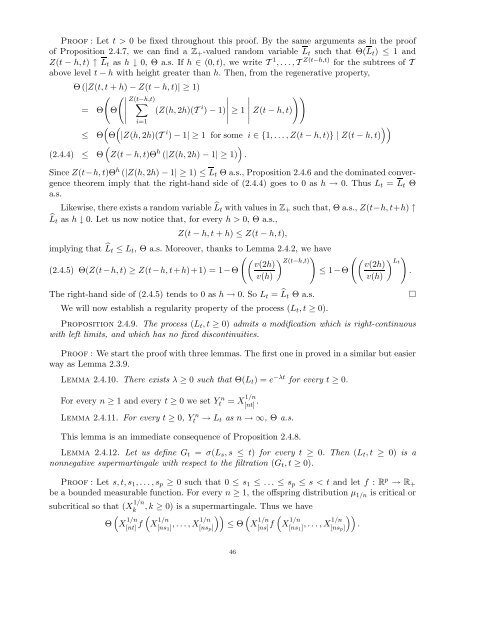arbres aléatoires, conditionnement et cartes planaires - DMA - Ens
arbres aléatoires, conditionnement et cartes planaires - DMA - Ens
arbres aléatoires, conditionnement et cartes planaires - DMA - Ens
Create successful ePaper yourself
Turn your PDF publications into a flip-book with our unique Google optimized e-Paper software.
Proof : L<strong>et</strong> t > 0 be fixed throughout this proof. By the same arguments as in the proof<br />
of Proposition 2.4.7, we can find a Z + -valued random variable L t such that Θ(L t ) ≤ 1 and<br />
Z(t − h,t) ↑ L t as h ↓ 0, Θ a.s. If h ∈ (0,t), we write T 1 ,...,T Z(t−h,t) for the subtrees of T<br />
above level t − h with height greater than h. Then, from the regenerative property,<br />
Θ (|Z(t,t + h) − Z(t − h,t)| ≥ 1)<br />
( (∣ ∣ ∣∣∣∣ Z(t−h,t)<br />
))<br />
∑<br />
∣∣∣∣<br />
= Θ Θ (Z(h,2h)(T i ) − 1)<br />
∣ ≥ 1 Z(t − h,t)<br />
i=1<br />
( (<br />
))<br />
≤ Θ Θ |Z(h,2h)(T i ) − 1| ≥ 1 for some i ∈ {1,... ,Z(t − h,t)} | Z(t − h,t)<br />
(<br />
)<br />
(2.4.4) ≤ Θ Z(t − h,t)Θ h (|Z(h,2h) − 1| ≥ 1) .<br />
Since Z(t−h,t)Θ h (|Z(h,2h) − 1| ≥ 1) ≤ L t Θ a.s., Proposition 2.4.6 and the dominated convergence<br />
theorem imply that the right-hand side of (2.4.4) goes to 0 as h → 0. Thus L t = L t Θ<br />
a.s.<br />
Likewise, there exists a random variable ̂L t with values in Z + such that, Θ a.s., Z(t−h,t+h) ↑<br />
̂L t as h ↓ 0. L<strong>et</strong> us now notice that, for every h > 0, Θ a.s.,<br />
Z(t − h,t + h) ≤ Z(t − h,t),<br />
implying that ̂L t ≤ L t , Θ a.s. Moreover, thanks to Lemma 2.4.2, we have<br />
( (v(2h) ) ) ( Z(t−h,t) (v(2h) ) )<br />
Lt<br />
(2.4.5) Θ(Z(t−h,t) ≥ Z(t−h,t+h)+1) = 1−Θ<br />
≤ 1−Θ<br />
.<br />
v(h)<br />
v(h)<br />
The right-hand side of (2.4.5) tends to 0 as h → 0. So L t = ̂L t Θ a.s.<br />
We will now establish a regularity property of the process (L t ,t ≥ 0).<br />
Proposition 2.4.9. The process (L t ,t ≥ 0) admits a modification which is right-continuous<br />
with left limits, and which has no fixed discontinuities.<br />
Proof : We start the proof with three lemmas. The first one in proved in a similar but easier<br />
way as Lemma 2.3.9.<br />
Lemma 2.4.10. There exists λ ≥ 0 such that Θ(L t ) = e −λt for every t ≥ 0.<br />
For every n ≥ 1 and every t ≥ 0 we s<strong>et</strong> Y n<br />
t = X 1/n<br />
[nt] .<br />
Lemma 2.4.11. For every t ≥ 0, Y n<br />
t<br />
→ L t as n → ∞, Θ a.s.<br />
This lemma is an immediate consequence of Proposition 2.4.8.<br />
Lemma 2.4.12. L<strong>et</strong> us define G t = σ(L s ,s ≤ t) for every t ≥ 0. Then (L t ,t ≥ 0) is a<br />
nonnegative supermartingale with respect to the filtration (G t ,t ≥ 0).<br />
Proof : L<strong>et</strong> s,t,s 1 ,...,s p ≥ 0 such that 0 ≤ s 1 ≤ ... ≤ s p ≤ s < t and l<strong>et</strong> f : R p → R +<br />
be a bounded measurable function. For every n ≥ 1, the offspring distribution µ 1/n is critical or<br />
subcritical so that (X 1/n ,k ≥ 0) is a supermartingale. Thus we have<br />
Θ<br />
k<br />
(<br />
X 1/n<br />
[nt] f (<br />
X 1/n<br />
[ns 1 ] ,...,X1/n [ns p]<br />
))<br />
≤ Θ<br />
( (<br />
X 1/n<br />
[ns] f X 1/n<br />
[ns 1 ],... ,X1/n<br />
[ns p]<br />
))<br />
.<br />
□<br />
46

















